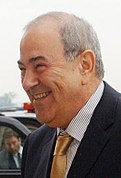January 2005 Iraqi election
|
|
|||||||||||||||||||||||||||||||||
|---|---|---|---|---|---|---|---|---|---|---|---|---|---|---|---|---|---|---|---|---|---|---|---|---|---|---|---|---|---|---|---|---|---|
|
|||||||||||||||||||||||||||||||||
|
All 275 seats to the National Assembly of Iraq 138 seats were needed for a majority |
|||||||||||||||||||||||||||||||||
|
|||||||||||||||||||||||||||||||||

Colours denote which party won the most votes in every governorate
|
|||||||||||||||||||||||||||||||||
|
|||||||||||||||||||||||||||||||||
Elections for the National Assembly of Iraq were held on January 30, 2005 in Iraq. The 275-member National Assembly was a parliament created under the Transitional Law during the Occupation of Iraq. The newly elected transitional Assembly was given a mandate to write the new and permanent Constitution of Iraq and exercised legislative functions until the new Constitution came into effect, and resulted in the formation of the Iraqi Transitional Government.
The United Iraqi Alliance, tacitly backed by Shia Grand Ayatollah Ali al-Sistani, led with some 48% of the vote. The Democratic Patriotic Alliance of Kurdistan was in second place with some 26% of the vote. Prime Minister Ayad Allawi's party, the Iraqi List, came third with some 14%. In total, twelve parties received enough votes to win a seat in the assembly.
Low Arab Sunni turnout threatened the legitimacy of the election, which was as low as 2% in Al Anbar Governorate. More than 100 armed attacks on polling places took place, killing at least 44 people (including nine suicide bombers) across Iraq, including at least 20 in Baghdad.
...
Wikipedia



